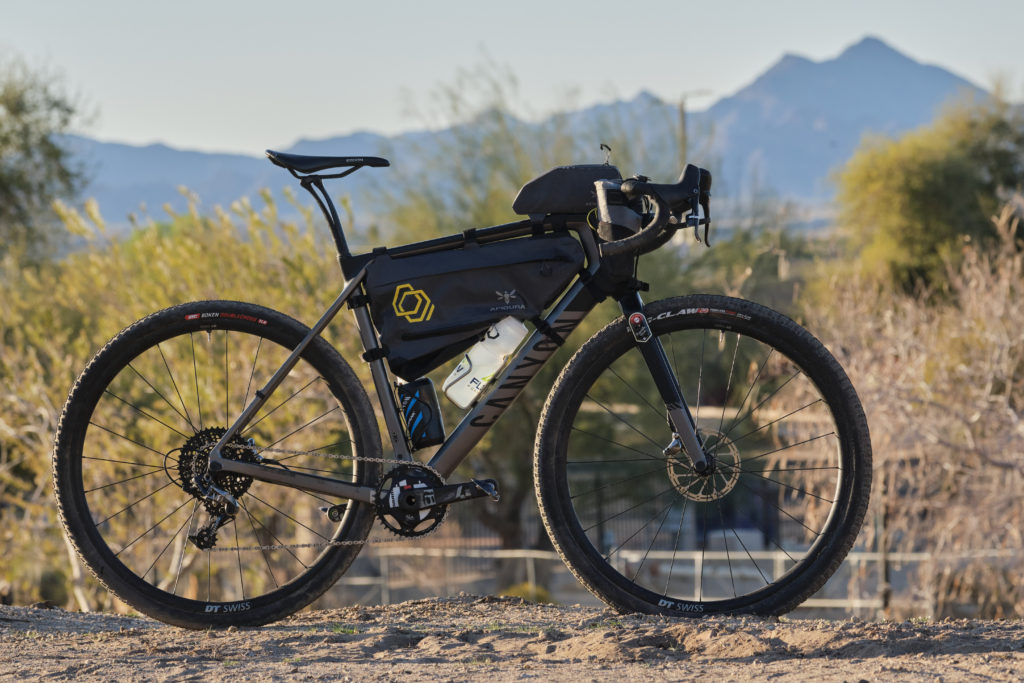JeremiahBishop.com
The Official Website of Jeremiah Bishop: Professional Mountain Bike Racer, Canyon Ambassador, and Cycling Coach
Impossible Route: Death Valley Day 2
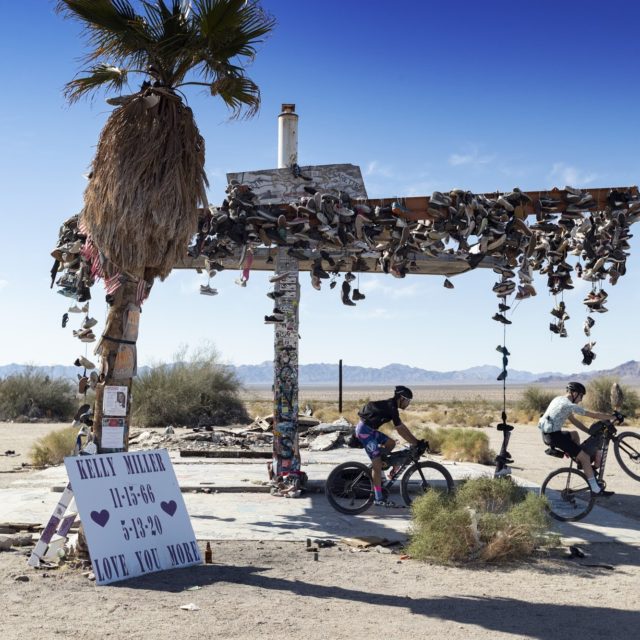
March 2: 130 Miles – Blythe to Hole in the Wall
Shoe Tree Chasing the Mirage
We started out in the crisp morning air, through great farmlands with small houses and palms of old Mexico. We turned a corner only to be stopped behind a massive herd of sheep. The men with their safety vests and sticks worked dogs to move the sheep. It was relaxing to be at the mercy of the sheep’s pace, but at some point we knew we needed to forge on.
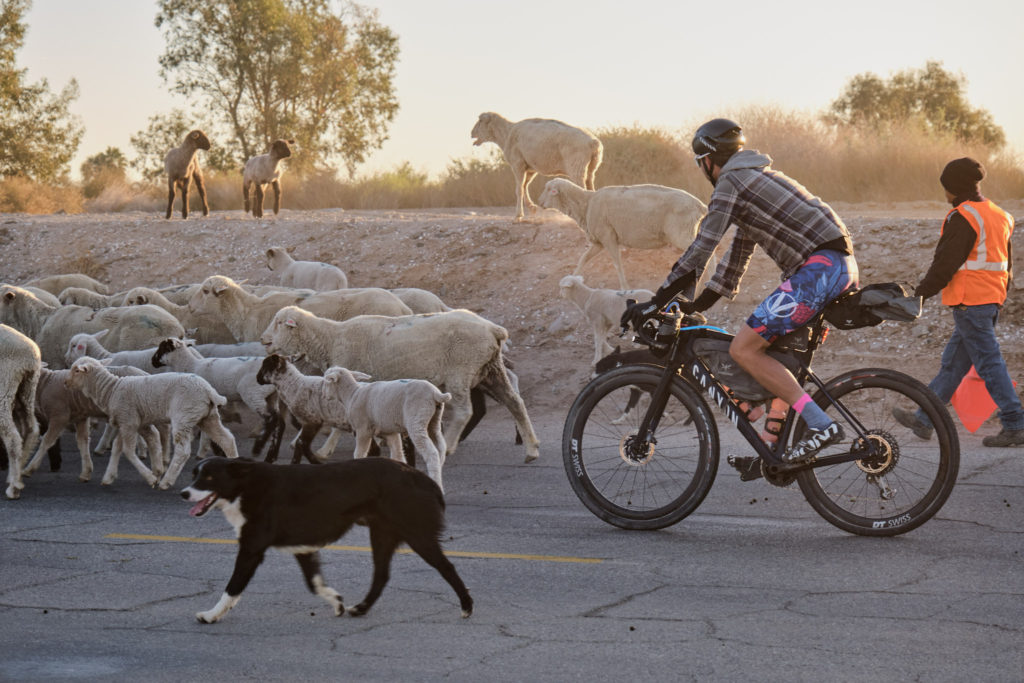
Today’s surface was a little firmer. We climbed northwest on Blythe Rice Road and over Styx Pass, enjoyed some magic vistas and very nice gravel. The track alternated between fast gravel and 1-kilometer-long sand patches that forced high power just to stay up, but today the rhythm change was tolerable and even fun.
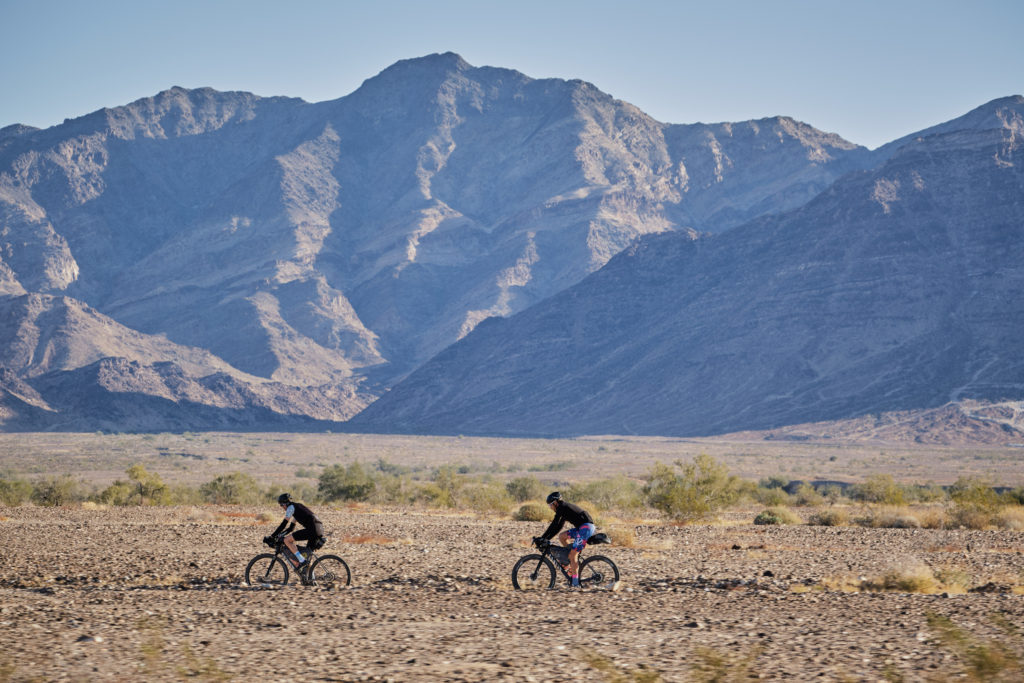
We stopped at the Rice Shoe Fence for some photos and to take in the modern art/trash installation that was something out of a post apocalyptic future movie. It was kind of creepy, to be honest – not the kind of place I want to be at nighttime.
We got back on route but struggled to find the correct road leaving the ghost town of Rice. We decided it was safest to take the plan-B route of Cabot Road where we were passed by giant trucks hauling salt with huge trailers. These desert titans on wheels flung dust trails like jet plane for miles. As we approached the horizon, it would just get farther away. At one point we spotted a town. “Look!” We were excited. A patch of little white square buildings in the distance surely meant water was near.
The closer we got, the farther the town seemed, until finally an hour later we arrived at an abandoned mine site. There were containers, gas tanks, earthmoving machines, oil tanks, sheet metal and buildings, but no people. No water. ‘Damn, I’m getting thirsty, “I thought. We continued west. Our left sides baking in the sun, the backs of our legs burned to purple. We encountered deep sand and again full effort rendered progress of just 4 miles-per -hour.
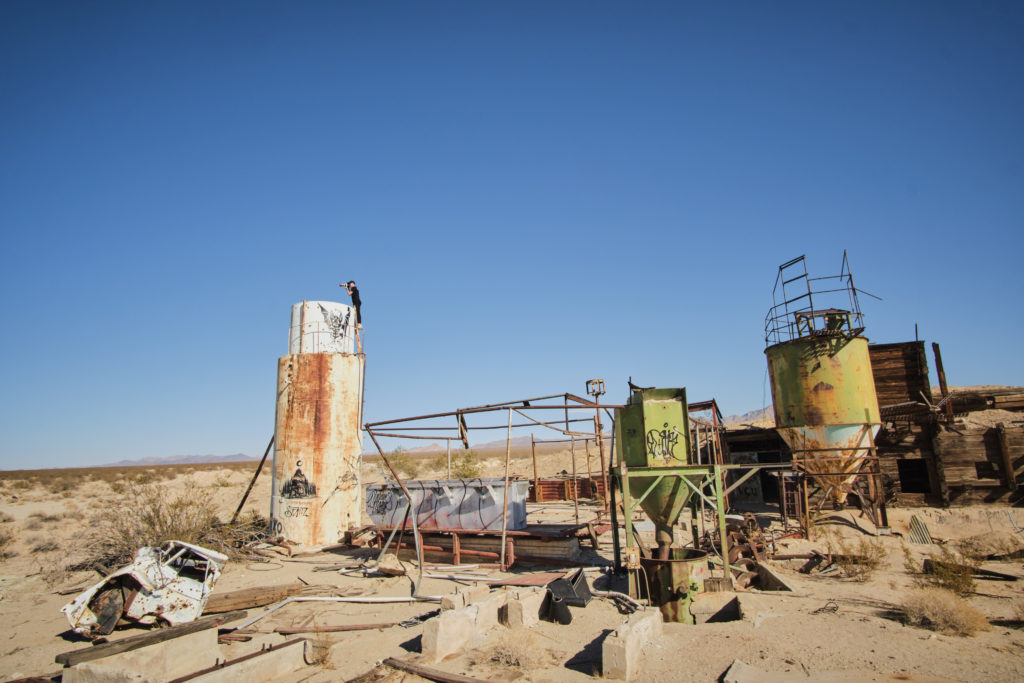
The sections that were hard-packed were gorgeous lunar landscapes in 360 degrees. Finally, after two hours, we arrived at an intersection. Upon crossing the tracks, we became excited because we saw the only human being we’d seen all day: a rail line maintenance worker, with a sweat-stained shirt, worn boots, and scruffy cowboy chin. He waved hello. Tyler chatted with him and scored us four little bottles of water. It was just what we needed to make it.
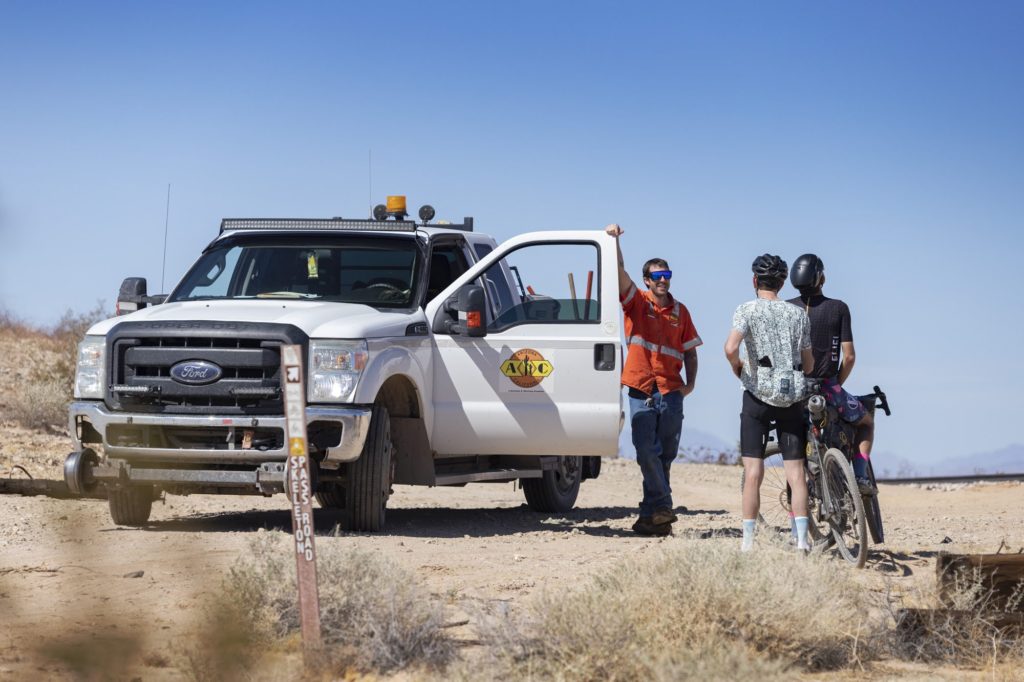
We opted for the pavement on Route 66 from Danby, but two completely washed out sections interrupted even that route. We rode right down the yellow line on what used to be the busiest road in the Southwest. I imagined folks in heavy metal cruisers traveling to San Diego or Las Vegas from Chicago. Now Route 66 is just dressed in sand, and cracked pavement, and old signs. The rough payment is a treat.
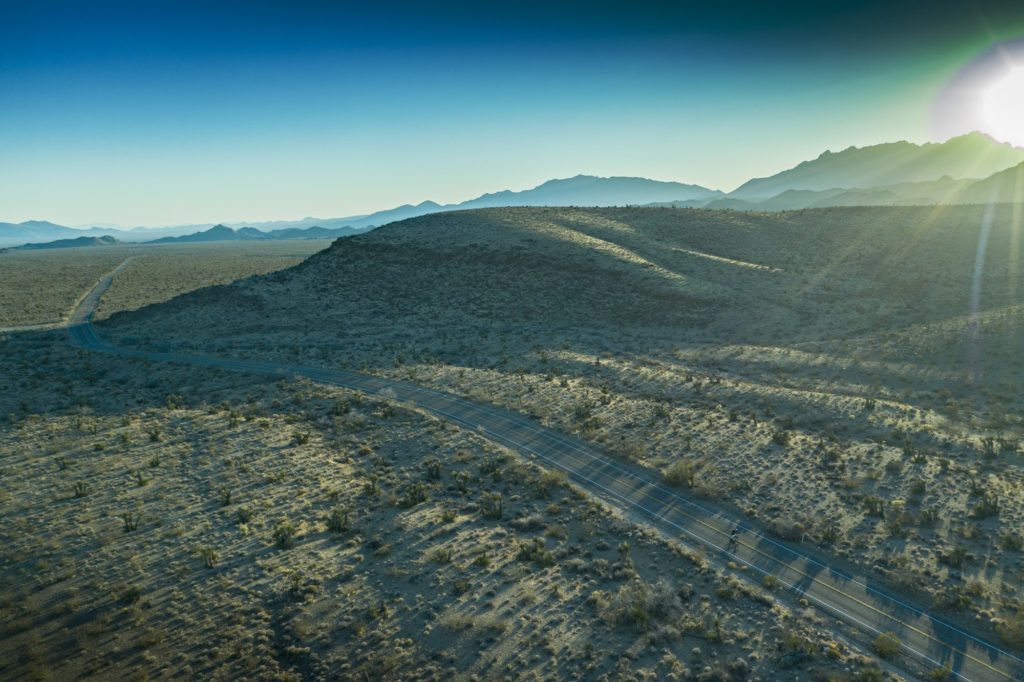
We upped our speed toward the abandoned town of Essex – the fourth ghost town that we passed. So many abandoned places and lost stories, and again no obvious signs of water. According to the map we just had to turn left and in 10 minutes, cross the highway, and go up one more hill. No problem, I thought. Then we looked in the distance and caught sight of the behemoth mountain and realized the scale of my map. Our jaws dropped. Because my GPS track was a 130-mile point-to-point, the scale fooled us. The interstate was 12 miles away. The warped space-time distance of the desert got us again. Tyler and I rode as fast as we could this late in the game, thinking top speed would get us there faster. He was out of food, so I gave him my last snack. I too paid for raising the pace. It was my turn to bonk in the last half hour. Two hours later, climbing away from the sunset our brains low on sugar, we spun the pedals on the steepening grade.
We had entered Mojave National Preserve. The Joshua trees at 4,000 feet stood guard like old men. In my mind, they welcomed us to a sacred desert, palm flags showing us the way up.
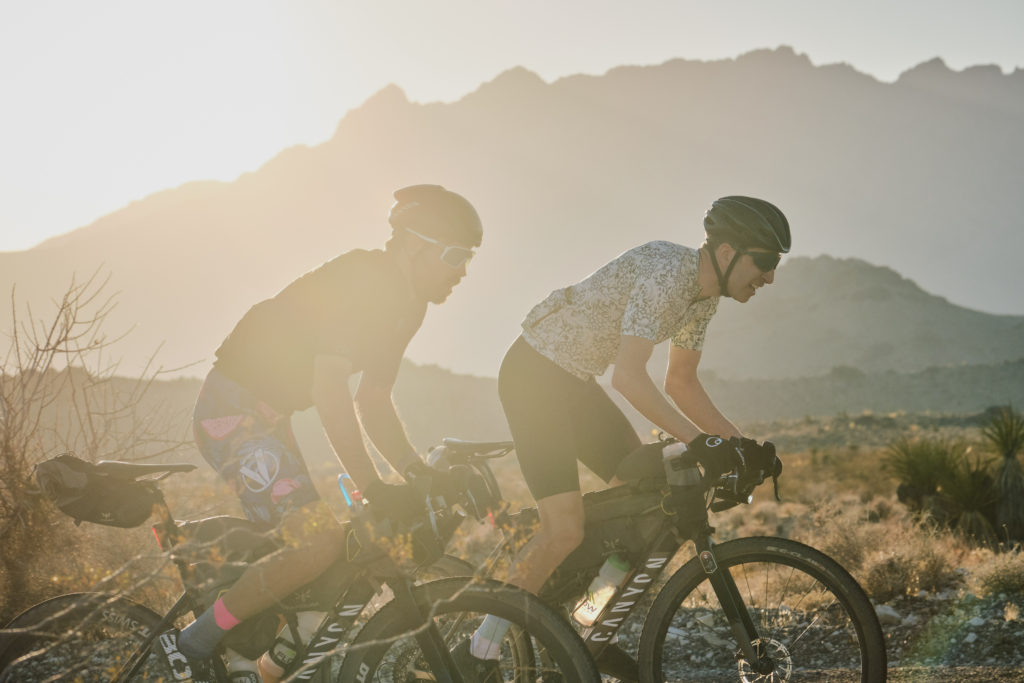
I was in the trance: The place in your head you get to only after incredible work and with a lack of mental diversions; Where the pavement passes underneath you like a conveyor belt of diamonds; The sky swirls like a van Gough painting. Long shadows stretched across the rippled desert as the sun dipped behind the mountain.
Part of the magic behind these efforts was the quest for some clear vision devoid of modern human influence. Breathe like breeze, blood rushing like a river, a reflection of mountain silhouettes in our eyes; we for once become more a part nature than of human kind for some brief moment. “###! This is Epic!” Tyler blurts out. Yep, I confirm this over-used word certainly rebranded in this moment.
Finally we arrived to the hole-in-the-wall campground nestled in a high saddle between the Woods Mountains and Providence Mountains in the Mojave National Preserve. A small applause erupted and I cracked a chapped smile.
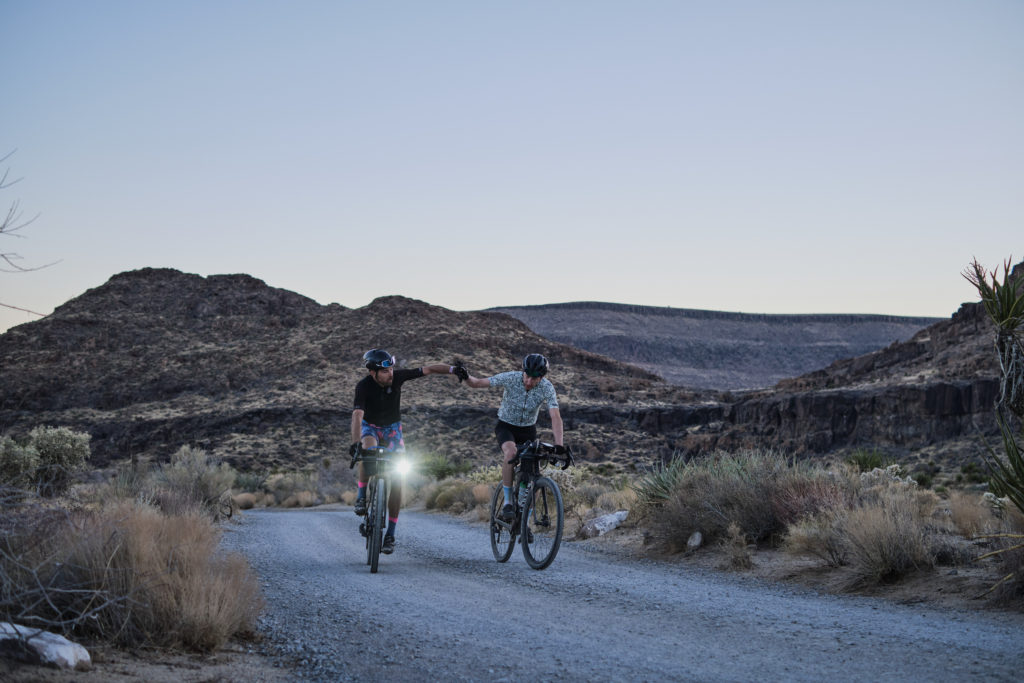
Round granite rocks, palms, cactus, yucca, and Joshua trees surrounded the campground. It was a beautiful place to call it a night. We rebounded quickly with a lot of Flow Recovery drink and water. We enjoyed laughing off the hardships of the day with the film team while eating incredible biryani and caramelized sweet potatoes Chef Biju cooked up.
This is the fourth of a nine-part journal of the Impossible Route: Death Valley expedition. Read part five. The journal is being released in conjunction with the feature documentary.
Impossible Route: Death Valley Day 1
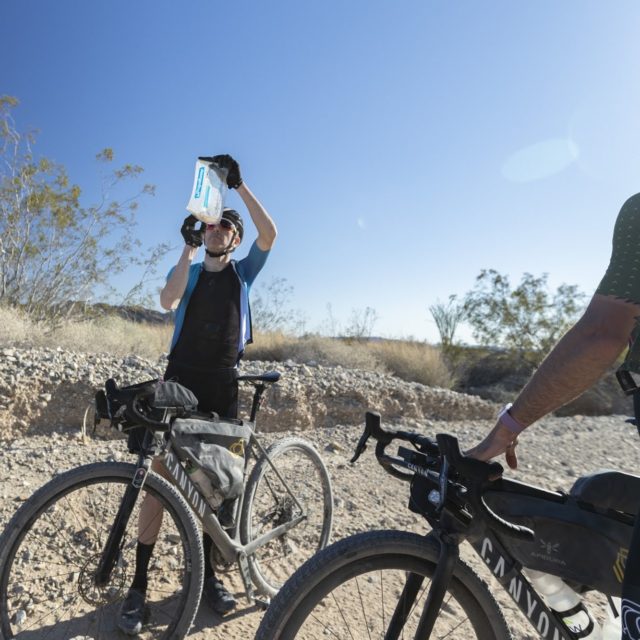
March 1: 120 Miles – Yuma to Blythe
No More Water?
Tyler and I were as excited as school kids off to the first day. The adventure started out well. We climbed north away from the US/Mexican border town of Yuma Arizona.
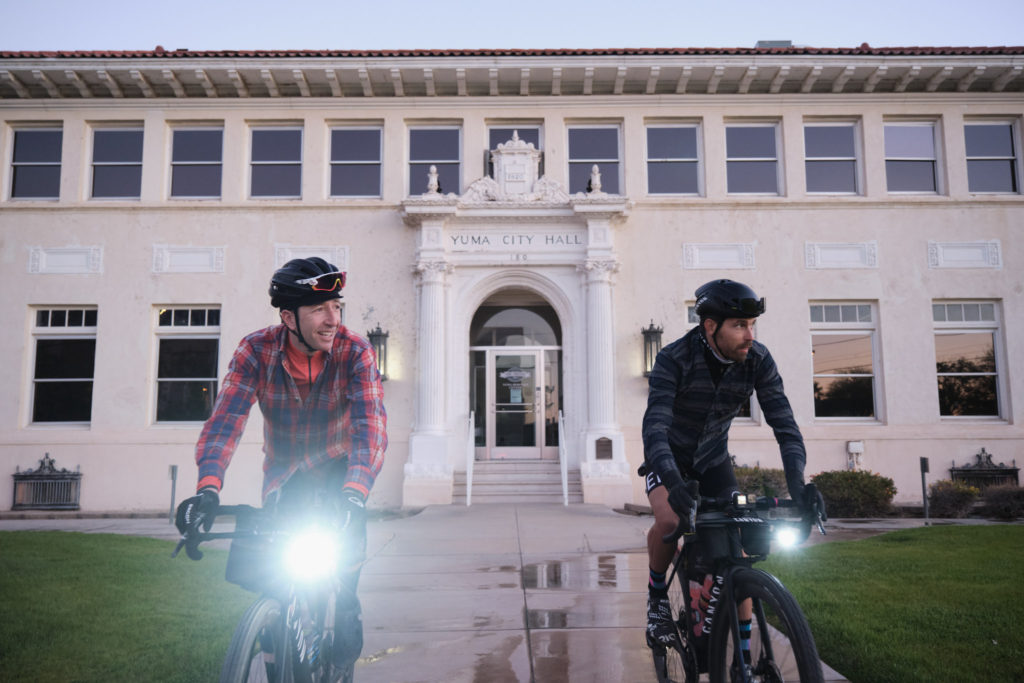
Into the wind, we started up the washboarded Picacho Road. The scenery became forbidding and increasingly desolate as we left civilization. The only spot of shade that could be found was next to a sign warning us that ahead there would be no gas, food, or water.
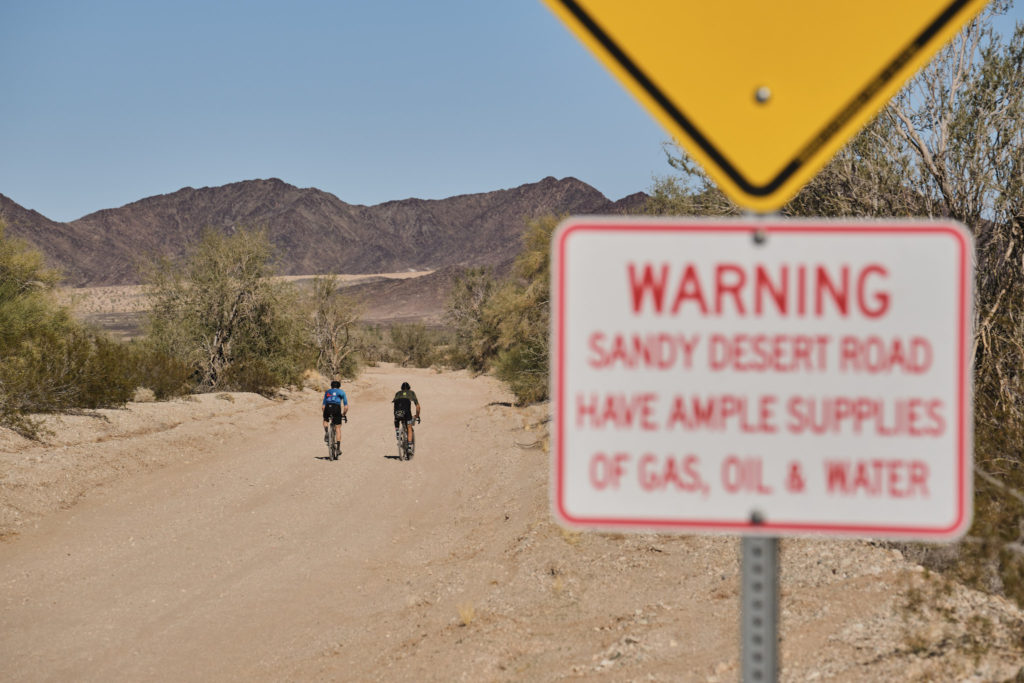
After two hours, we crested a gap between two mountains – the Picacho Mine overlook. We froze in our tracks. The view of the rough Trigo Mountain Wilderness was mesmerizing. The jagged peaks layered endlessly in the distance. Tyler and I had a collective “oh, shit!” moment. We just caught the first glimpse of our opponent.
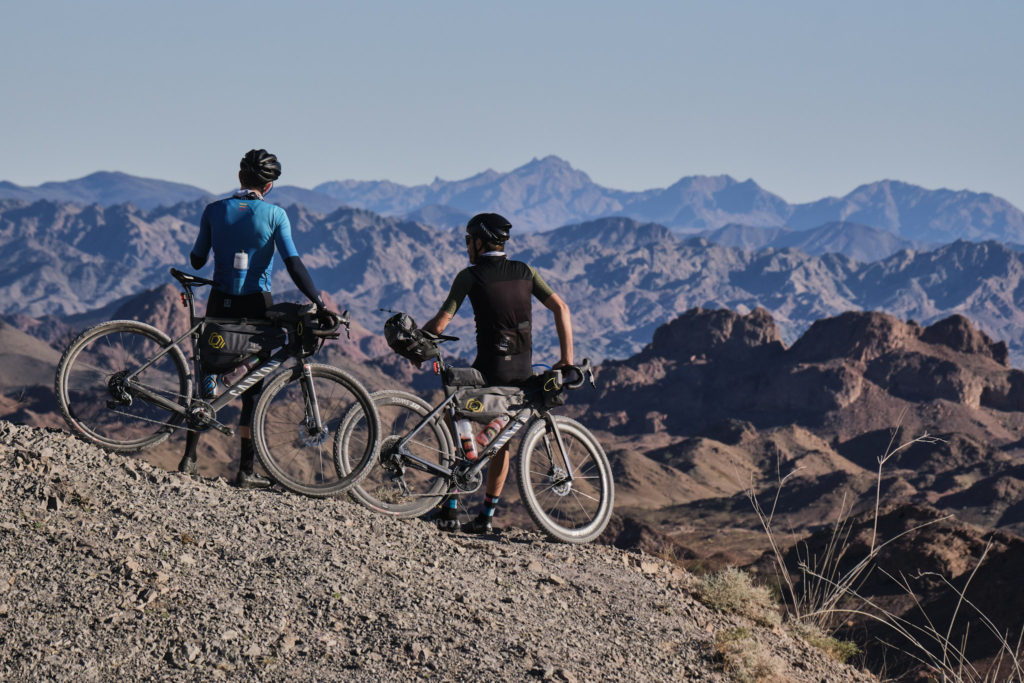
We remained optimistic as we passed through Picacho State Recreation Area and merrily passed our last possible water source, the Colorado River, before entering the sandbox. At first the sand was rideable, but approximately 4-miles-long, it tested our patience with on-and-off the bike falling. Our frustration lead to anger, and our anger led to doubt. At one point, I broke out laughing because it was all I had left to cope. We felt like two little flies stuck on flypaper, barely able to move, but we kept going.
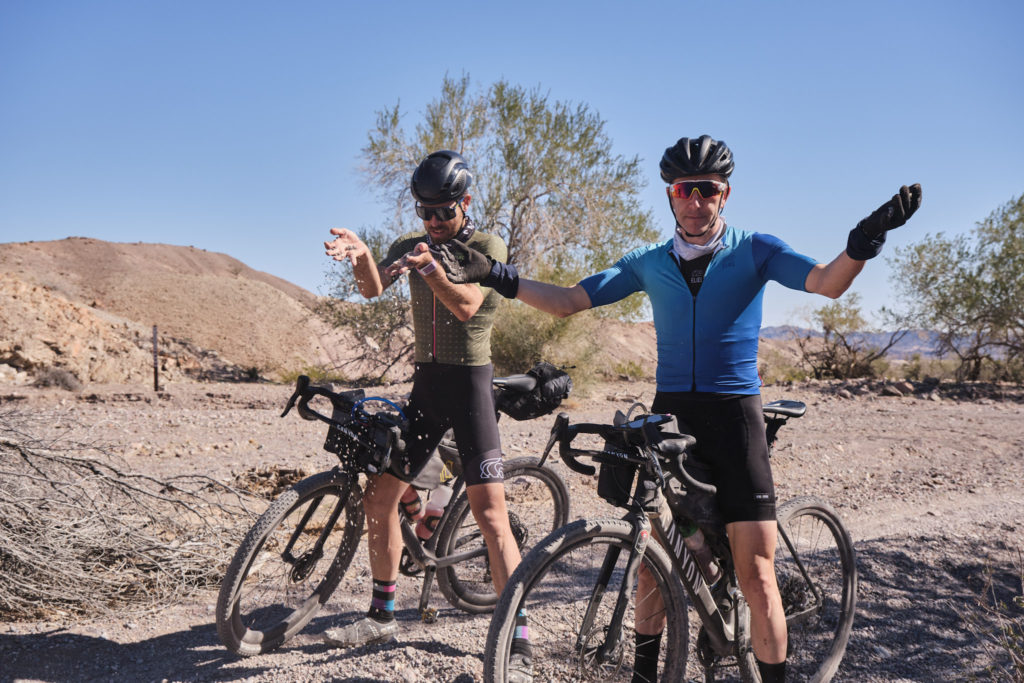
Tyler’s shoe broke and we had to stuff a buff in it so it wouldn’t stab him in the foot. We kept going, feet aching, arms tired from pushing the bike, and the heat was climbing into the low 80’s. This had us sucking down our water much faster than planned. Finally we passed a guy on a four-wheel dune buggy. He tossed us some water (trail angel!) and said, “Hang in there, guys! A quarter-mile and the sand is done!”
Freedom! We climbed up out of there and felt like we’d escaped the first trap of the route. Only 660 miles left.
The pavement on Route 78 was pretty sketchy and there were a lot of big trucks passing, so I was excited to turn left on Milpitas Wash Road. We stopped and tried to cry because looking ahead we could see it was another river of deep sand and rocks.
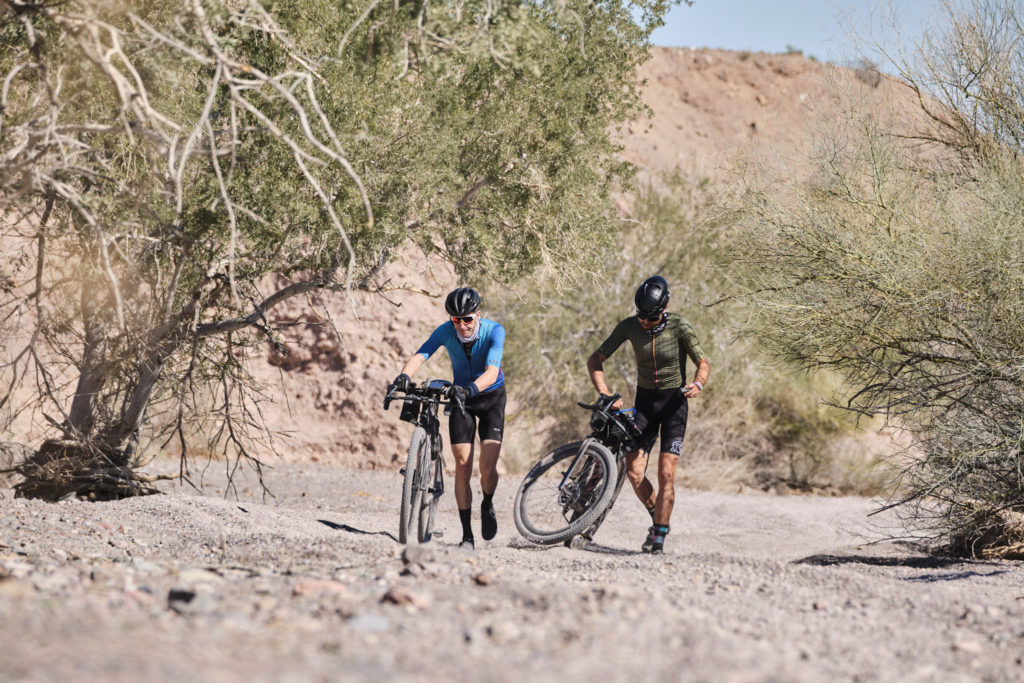
Riding but mostly walking for a half mile, “It will get better,” I said. This was my promise of the week to keep Tyler’s morale up. Once we escape the sand, it was on washboard. The thing is when you’re riding at 4 miles an hour in the blazing sun doing high power just to stay upright, you go through water fast. We ran out with 20 miles to go, as we approached Bradshaw Trail.
Turning right on Bradshaw Trail, we were greeted by our old friend the sand. This time it was more like a river of pebbles. They were the size of dimes, quarters, and nickels. Our tires sank and so did our spirits. Exhausted and out of water, we have been riding for eight hours. We took the lids off our water bottles and sucked the last drop of water from the tube connected to my hydration bladder. Already my head was throbbing from dehydration.
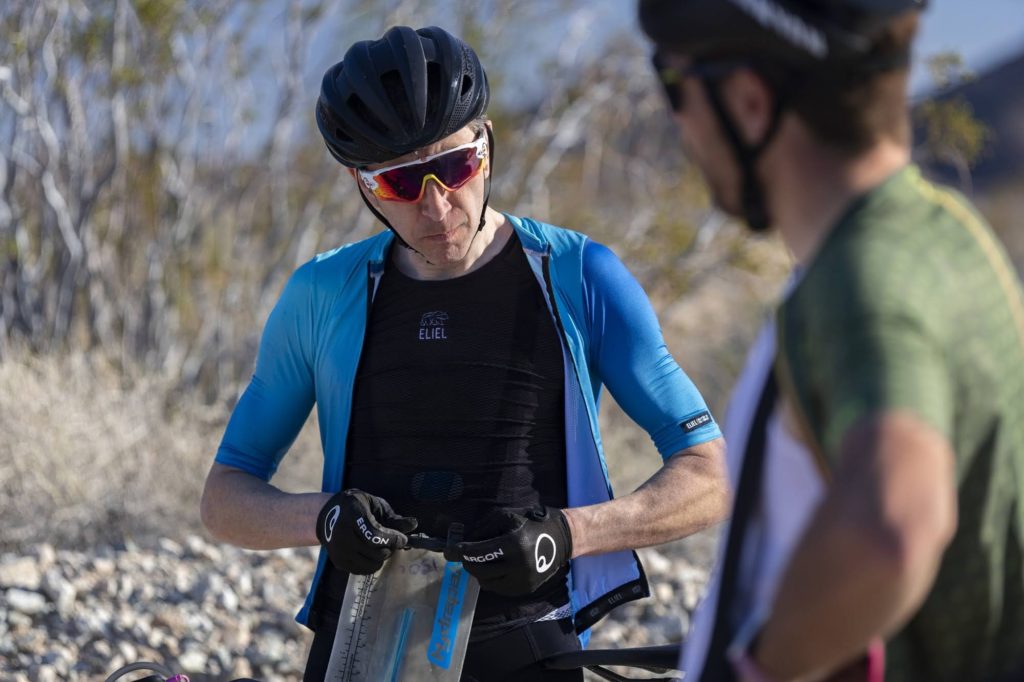
Tyler asked Dale how much farther?
Dale said, “13 miles.”
Tyler said, “No way I can make it 13 miles with no water on this trail.”
I coaxed him to just make it to the top of the hill. Then we can coast down to town and maybe find water halfway there. Of course this was a lie, because I knew there was no water on the other side of the mountain, but it kept us moving. We found a motorcycle family and Tyler batted his eyelashes scoring us some water and saving the day.
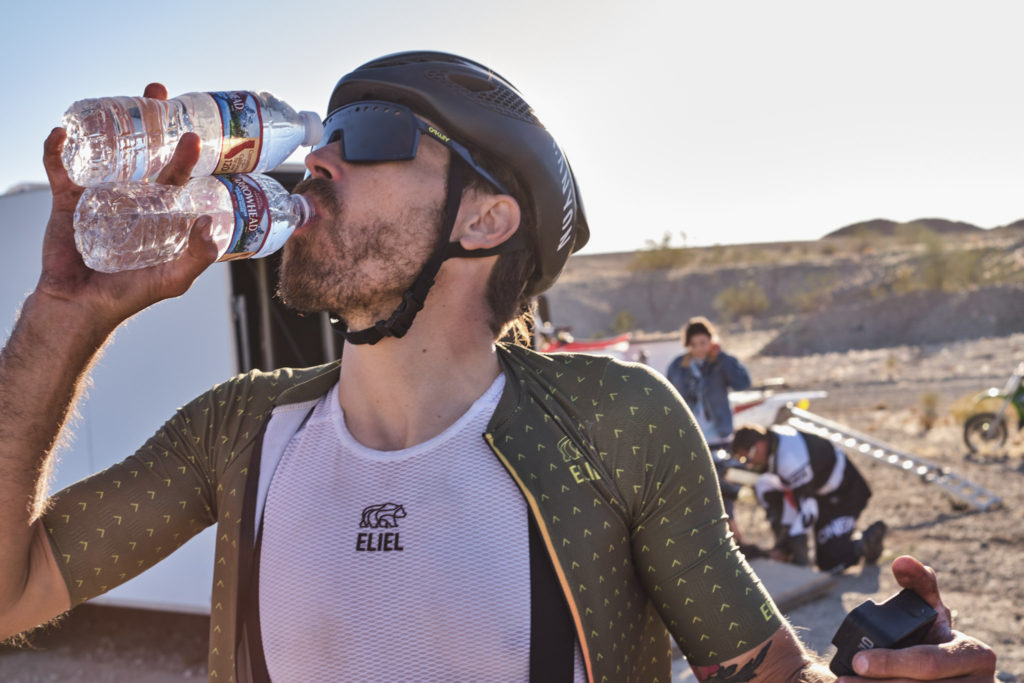
We sped over the final six miles that were paved. We were so happy to see the campground and ready for some awesome food, but we also realized that riding sunrise-to-sunset every day with very little recovery was going to smash us and become unsustainable.
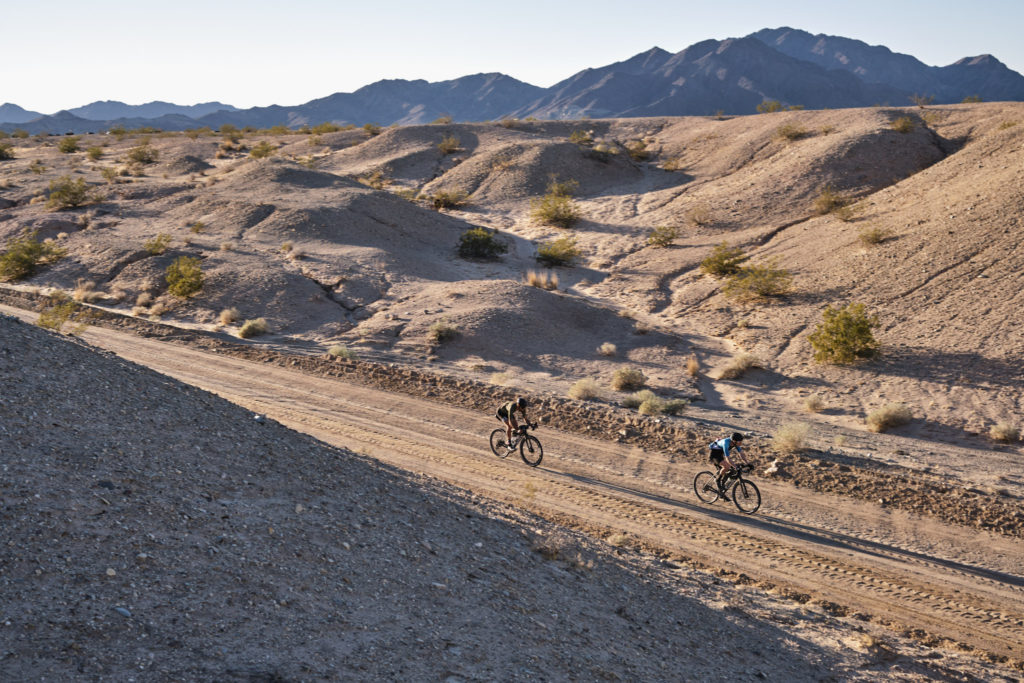
This is the third of a nine-part journal of the Impossible Route: Death Valley expedition. Read part four. The journal is being released in conjunction with the feature documentary.
Impossible Route: Death Valley – Eve of Adventure
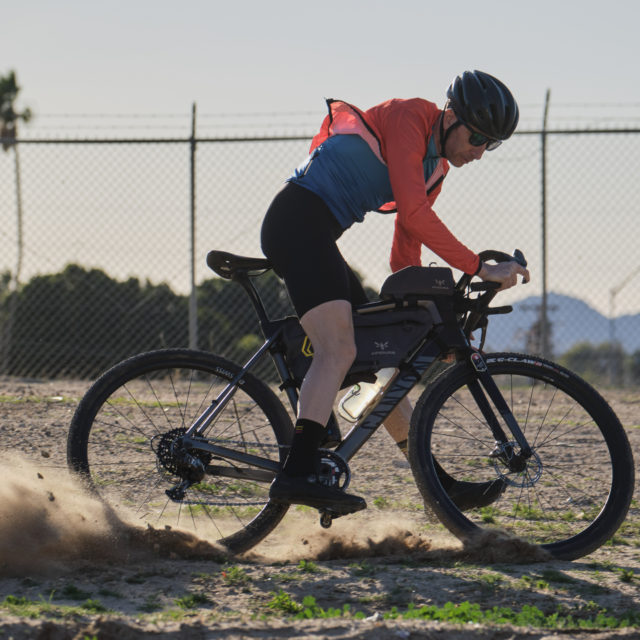
February 28 – Prep Day
Nervously we hustled to prepare all the gear, not really sure if we had the right equipment or enough of it.
We put the Apidura bags on our bikes barely knowing how the straps worked, we download a GPS track, and tried to turn on satellite phones we also didn’t know how to use. We mounted up our new IRC tires and installed our lights on our trusty Canyon Grails.
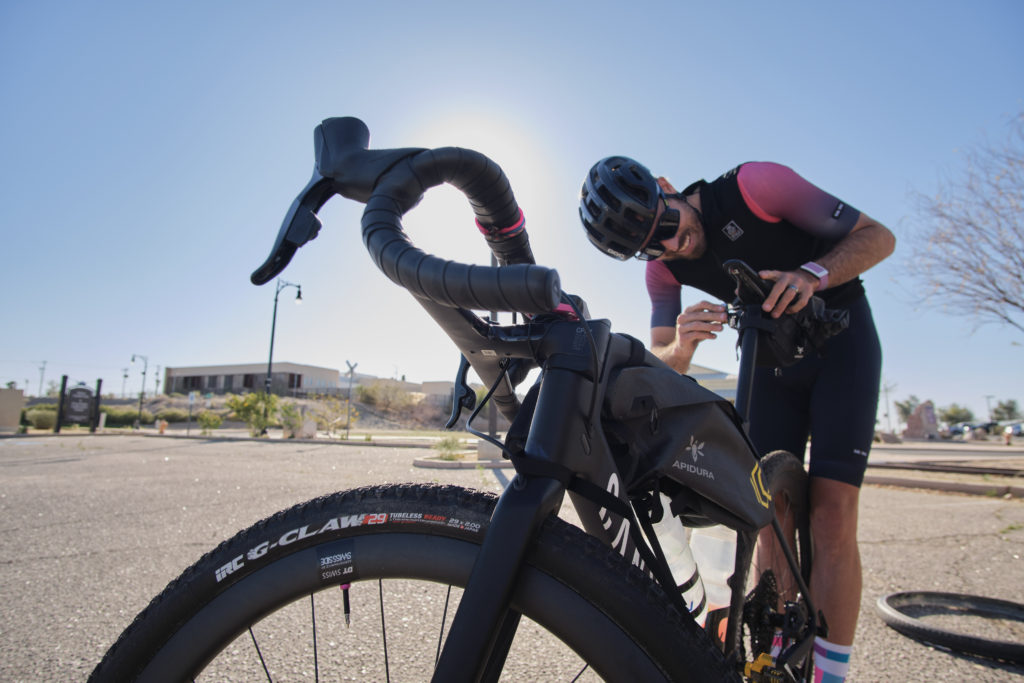
To say we were in over our heads is the understatement. We were like the local rock climbing club setting out for El Capitan.
I assured everybody that things were under control, while inside of my head I was certain we were going to die or get lost in the desert with no water and 6 flat tires.
We did pre-ride interviews by the river. At sunset, the wind was picking up and so was our mood.
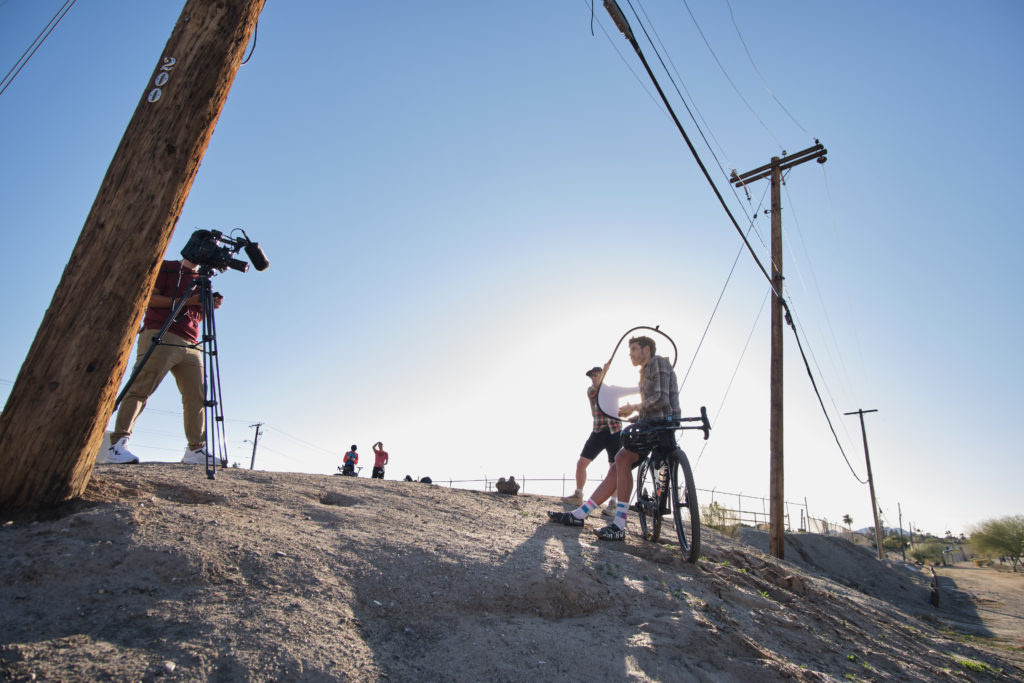
Nervous and excited, we knew that the next morning we would roll out of the only city we’d see for 750 miles. Logistics challenged us and our timeline was crunched, but like a rocket taking off, it didn’t matter if we were ready just if we were willing. I stressed at the sheer amount of prep we had only given one day to execute. It was crunched, but it just worked!
This is the second of a nine-part journal of the Impossible Route: Death Valley expedition. Read part three. The journal is being released in conjunction with the feature documentary.
Impossible Route: Death Valley – Team Arrives
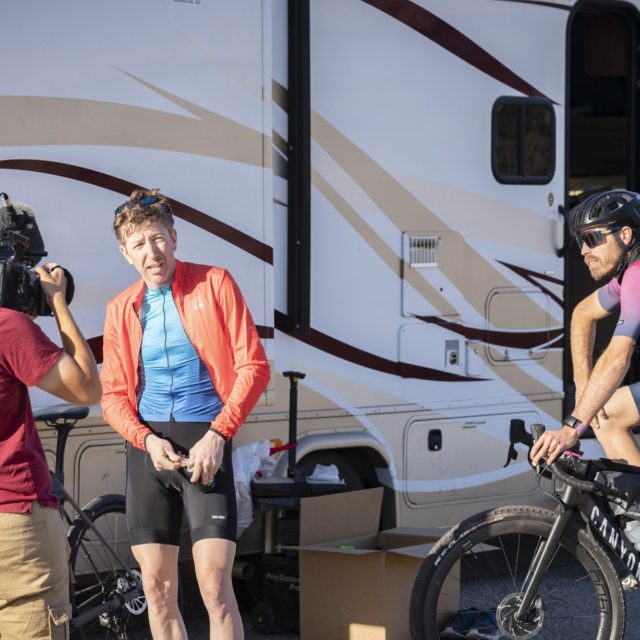
February 27th: Arrival in Yuma, Arizona
The Impossible Route team arrived about as prepared for it as a groom to a shotgun wedding.
For months, we’d planned on paper, but this was the Mojave Desert and Death Valley; and they would definitely hold some big surprises.
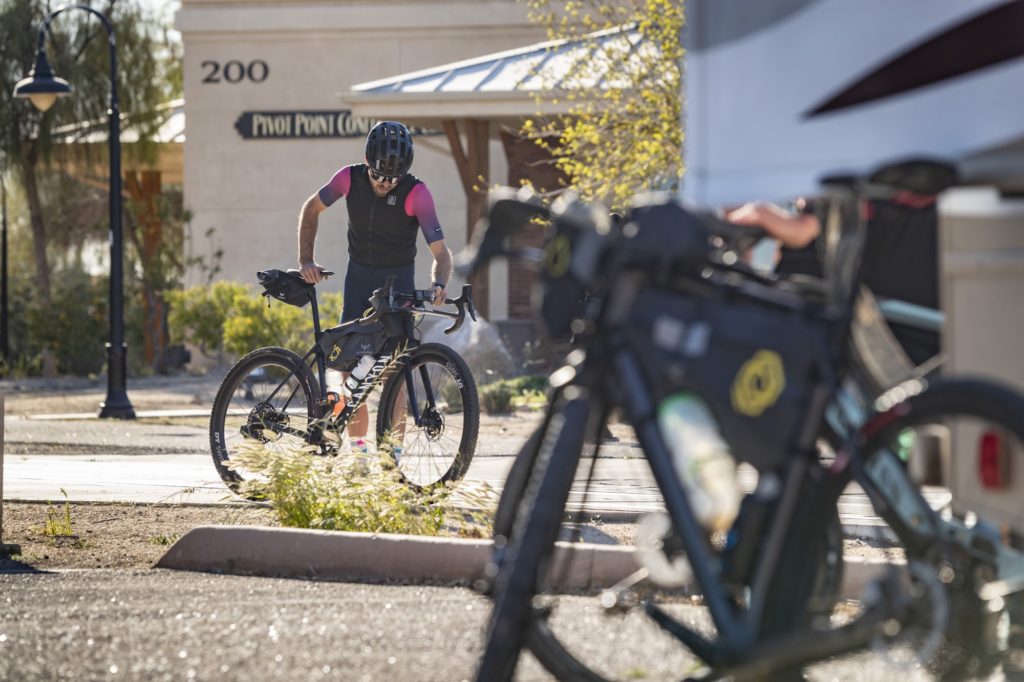
The absurdly ambitious mission was to see if it was possible for Tyler Pearce “The Vegan Cyclist” and me to ride the core of the California Back Country Discovery Moto route and keep up with the motorcycle itinerary. Now only a damn fool would think this is possible, but both VC and I are qualified as knowing-no-bounds foolish.
For our rules, we would ride self-sufficient like a mountain bike stage race; only getting food, water, and resting at the villages or camps that punctuate the otherwise unthinkable desolate deserts.
Each day’s route would be about 110 miles, over sand and rock, through heat and cold, and under the burning sun; but our hand was full of aces! We have an outstanding team to capture this amazing effort and our food bar none. Finish or not, we would deliver some stunning photography, incredible videos, and great resources for those who follow behind us who will try the route.
We tested, pre-quarantined, and traveled with the highest level of caution to arrive safely to our bubble in the desert.
I hopefully asked my friend, the celebrated chef, Biju Thomas to join us, thinking he would have to say no because of all that he has on his plate (Dad Joke pun!), but he said yes! He ran camp life like a boss as well as keeping us fed with nutritious food.
Here’s a look at our Impossible Routes dream team:
Biju Thomas, a celebrated chef with great experience serving elite cycling teams.
Ramy Khalaf, our amazing risk-taking videographer.
Jake Orness, the artist-eyed and phenomenal photographer for Eliel.
Our “Aussie” Dale Travers, driving and shooting amazing social media.
The “young gun,” Travis Longfellow bicycle mechanic and support driving.
My nervous riding partner Tyler Pearce “The Vegan Cyclist,” the funny guy and our inspiring storyteller.
And me, the tough guy former pro whose job is to make barely possible challenges more possible.
What a great group to take on this unique mission.
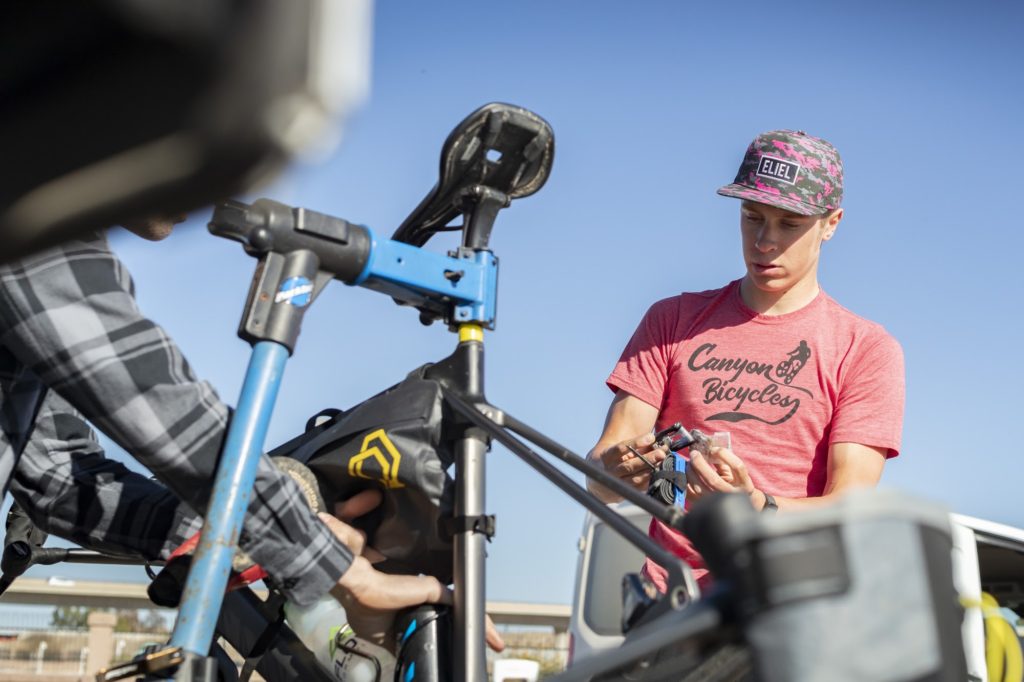
The goal is to ride a gravel version I’d planned of the California Backcountry Discovery Route moto route. The course would be 750 miles from Yuma to Bishop over 7 days. I was fairly certain our chances to complete this were 50/50, when considering our rules of taking no outside assistance from our media team while riding, but trail angels or other good luck was fair game.
The basis of these rules comes from my experience riding the two-person Cape Epic mountain bike stage race. No outside assistance during stages and we both must ride together working as a team. What’s more, we had brought gravel bikes to a very rough place. Like a switchblade to a gunfight, but why not try? I think it can be a beacon of hope for folks who have been pent up for a year and we could inspire others to get out of their comfort zone.
This is the first of a nine-part journal of the Impossible Route: Death Valley expedition. Read part two. The journal is being released in conjunction with the feature documentary. Click here to learn more about The Impossible Route series.
E-Sports Cycling Comes of Age
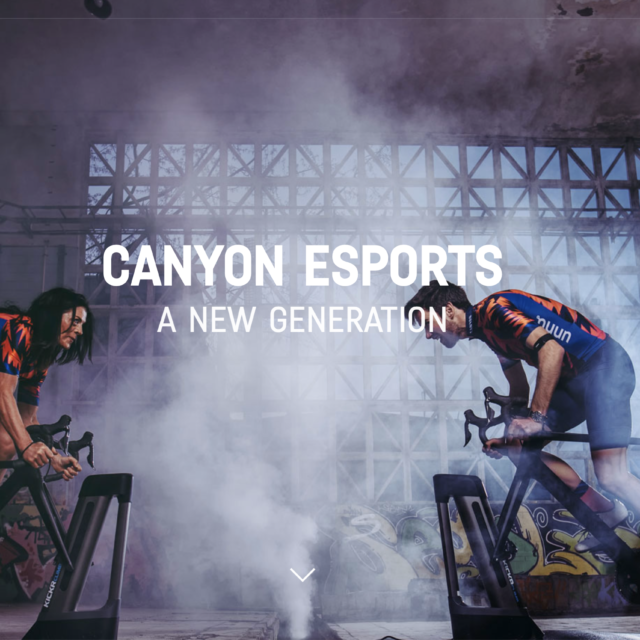
Announcing Your Zwift World Champions
Since its launch in 2015, the indoor web-based cycling platform Zwift has seen over 2.5 million accounts registered across 190 countries. Zwift’s valuation of $1.1 billion is hard to comprehend, as that puts its worth as more than some of the bigger bicycle manufacturing brands.
“That’s impressive,” you might think, “but the racing part is phony, right?”
Well, what if I told you there are at least 12 professional teams specializing in online racing?
Just this month the final piece of the puzzle came boldly into place. The UCI (the international governing body of cycling) hosted the first E-sports World Championship title event. Ashleigh Moolman-Pasio of South Africa and Jason Osborn of Germany took home the gold medals. The live televised race was not only on Eurosport, but several other TV channels, in addition to YouTube. National team riders competed against star-studded fields of indoor specialists and IRL (in real life) riders from a range of disciplines, including undisputed power houses like Tour de France star Rigoberto Urán, World Hour record holder Victor Campenaerts, mountain bike star Annika Langavad, and 2017 World Champion triathlete Lionel Sanders, to name just a few.
All riders had to undergo stringent checks of power meters and body weight and were supplied calibrated trainers on which to compete. The race was for a pixelated rainbow jersey, and what’s more it offered $32,000 USD in prize money. This purse puts the event at the low end of the Pro Video Game E-sports prize money and viewership rankings. However, glancing at some of the latest competitions in other e-sports, you’ll see the potential for prize money to one day rival World Tour races.
Many could have seen Ashleigh Moolman-Pasio’s explosive win coming because of the top tier pro’s Zwift focus this season, but Jason Osborn? Jason is an Olympic rower with incredible palmares that span world titles and world records. When he went early in the final uphill sprint, the favorites hesitated. Their reaction came in the form of an astounding 700-900 watt surge up the second half of the climb, but it was too late close the gap.
Jason, like other top-level rowers, has a special gift due to his competitions being max intensity 5-minute efforts, and therefore he’s developed the strength to tolerate insane lactate levels. For rowers maximum heart rate for 5 minutes at a time is totally normal.Jason used this perfectly timed attack to surprise the field. Next time he will be a marked man!
There is something cool about Zwift bringing super power talents over from triathlon, rowing, and various other sports. This elevation in competition and the unique aspects of Zwift make for unpredictable events that are joys to watch.
It’s got me thinking that perhaps this winter I need to do some rowing for cross training?
As a long time Zwifter, it was a treat for me to moonlight on the Canyon Esports powerhouse team for a couple of races. This new level is quite humbling. It’s a different game – kind of like jumping into a crit race as a stage race specialist. In Zwift’s earlier days, you had a good chance at success if you showed up stronger than everyone else, but now it’s a loaded international field of career-athletes and e-sport specialists.
A few saw it coming, but not many could have predicted the events of this year’s pandemic. Its effect on e-sports, especially Zwift, has been like pouring lighter fluid onto a backyard grill.
An exciting thing about this growth is that now there are more club teams and new ways to be involved. Canyon Esports started a community club for anyone who wants to join in and have fun. And for east coast US riders, you can join three Slowtwitch teams in ZRL – all in America’s East coast time zone with an A, B, and C option for tons of fun!
What’s ahead for racing is anyone’s guess, but for the next couple of months tune in to watch the pros duke it out in the professional invite-only Premier Leagues on Zwift. The Premier Division has professional invite-only races and the Community (or in other words, open amateur classes) hosts leagues across the different time zones: Asia, Europe, Eastern America, and Western America. If you live in India or Hawaii, you’ll have to decide if you’re a night owl or a morning person. Top teams in the amateur division can upgrade to the ranks of the Premier. With around nine exciting rounds of racing in January and February 2021, the platform will feature various courses and distances, including team time trails.
Meanwhile on the RGT platform, some of the USA Cycling Races that were previously canceled have been reborn as the Echelon Racing League. This series takes on some great courses with a lot of variety. Iconic American events like Tour of the Gila, Bucks County Classic, and Redland Classic have seen their rebirths happen online.
I’m stoked to be joining the Slowtwitch rise and shine ride on the first Thursday of the month for a brisk-but-not-all-out effort. I wonder if we can get Dan Empfeild out of bed at 2AM to join in?
E-sports cycling is here and has just put a foot in the bottom step of the lucrative e- sports industry. Will there be tournaments with $750,000 for first place? Only time will tell.
The fire is bight, but like lighter fluid sprayed about it’s hard to predict where and how it will grow. In the meantime, look for some sparks to fly and stars in the making.
Jeremiah Bishop
Additional resources and cool links:
• For racing, check out www.ZwiftPower.com for a calendar and power verification rankings page.
• Follow @ZwiftHacks for great tech tips and tricks.
• For non-racing news, see ZwiftInsider.com. They host the Power Up podcast and feature
tech reviews.
• Info about the Echelon Racing Series.
• For coverage of the Echelon racing series, subscribe to the YouTube channel.
• To spectate professional races, subscribe to the Zwift YouTube Channel.
• Check out GPLama for tech reviews and game updates.
• Zwift’s competitors seem to have lost some ground with the former’s huge boost from venture capital, but they are worth checking out. FulGaz.com has nice graphics. Rouvy.com has hosted some high-profile races like Ronde van Vlaanderen. Last, but not least, RGT or Road Gran Tours platform features unique game play, with braking in-turns and realistic solid riders you can’t ghost through.
